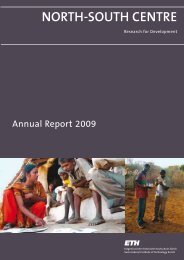Annual Report 2006/07 - ETH - North-South Centre North-South ...
Annual Report 2006/07 - ETH - North-South Centre North-South ...
Annual Report 2006/07 - ETH - North-South Centre North-South ...
You also want an ePaper? Increase the reach of your titles
YUMPU automatically turns print PDFs into web optimized ePapers that Google loves.
Research fellow (Post-doc)Christine Flury, SHL Zollikofen,SupervisorsStefan Rieder, SHL Zollikofen /Olivier Hanotte, ILRI, Kenya /Henner Simianer,University of Goettingen, GermanyCollaboratorMiika Tapio, ILRI, KenyaDurationFebruary 20<strong>07</strong> – January 2009Research Fellow Partnership ProgrammeMarker-based estimation of effective population size:Application to the conservation ofindigenous African cattle populationsDemographic information is often lacking for livestockbreeds of the developing world. Therefore, effective populationsize – a major criterion to assess the degree of breedendangerment – cannot be calculated. However, basic populationinformation is crucial for priority-setting in livestockconservation and thereby for the sustainable managementof local breeds. In this project, a molecular method for theefficient estimation of effective population size is proposed.We will be using the information from molecular markers.be a powerful tool for the estimation of effective populationsize of local cattle breeds. If found to be positive, the newmethod would permit the efficient accumulation of basicinformation on animal genetic resources in developing countries,which is still lacking.The investigation of the new method is the subject of aresearch partnership between the Swiss College forAgriculture, Zollikofen, Switzerland, the InternationalLivestock Research Institute, ILRI, Nairobi, Kenya, and theInstitute of Animal Breeding and Genetics of the Universityof Goettingen, Germany. The partnership is expected tocontribute profound knowledge regarding animal breedingin developing countries, molecular genetics and conservationof animal genetic resources.The first meeting was held at the end of April 20<strong>07</strong> inNairobi. The research plan, the capacities and the next stepswere discussed. Back in Switzerland, the research fellow conducteda detailed literature analysis and started to investigatethe properties of the approach with computer simulations.Meanwhile the properties of the molecular markerswere analysed at ILRI.As a direct outcome, the optimum sampling /genotypingscheme and the further course of action will be defined. DNAsamples from two African taurine cattle breeds have beenprovided by ILRI. These samples will be genotyped at ILRI,starting in the last quarter of 20<strong>07</strong>. The results from thegenotypings will be analysed in Switzerland. These analysesare expected to reveal whether the proposed method wouldN’Dama herd in Guinea –Samples from animals of this population will be analysed59
















